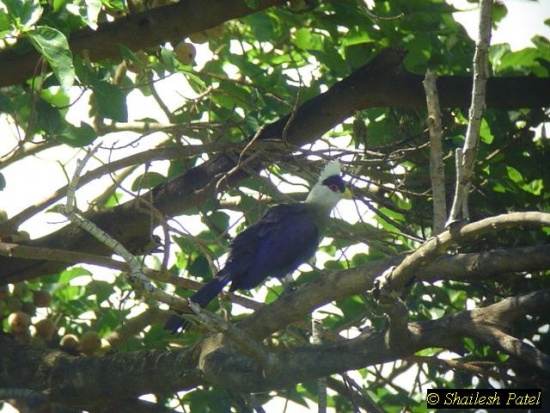(completed) |
(→Taxonomy: Update link) |
||
| Line 15: | Line 15: | ||
Found from extreme southeast [[Nigeria]] to northern [[Cameroon]] and east across southern [[Chad]] and northern [[Central African Republic]] to [[South Sudan]], northeast [[DRC]], Uganda and western [[Kenya]].<br /> | Found from extreme southeast [[Nigeria]] to northern [[Cameroon]] and east across southern [[Chad]] and northern [[Central African Republic]] to [[South Sudan]], northeast [[DRC]], Uganda and western [[Kenya]].<br /> | ||
==Taxonomy== | ==Taxonomy== | ||
| − | This is a [[Dictionary_M- | + | This is a [[Dictionary_M-O#M|monotypic]] species. |
| + | |||
==Habitat== | ==Habitat== | ||
Open woodland, gallery and riverine forests.<br /> | Open woodland, gallery and riverine forests.<br /> | ||
Revision as of 21:00, 4 July 2014
- Tauraco leucolophus
Identification
40cm. An unmistakable Turaco.
- Pure white crest, cheeks and neck
- Contrasting glossy violaceous blue-black lores, forehead, forecrown and area behind eyes
- Black narrow line under eye
- Scarlet bare orbital skin around eye
- Pale greenish throat
- Grass-green mantle and breast
- Glossy violet blue lower back, wings, rump and tail
- Blackish belly and undertail coverts
Sexes similar, immatures similar to adults.
Distribution
Found from extreme southeast Nigeria to northern Cameroon and east across southern Chad and northern Central African Republic to South Sudan, northeast DRC, Uganda and western Kenya.
Taxonomy
This is a monotypic species.
Habitat
Open woodland, gallery and riverine forests.
Occurs from 100m up to 2200m.
Behaviour
Diet
Feeds mainly on fruits and berries. Takes also some flowerheads and snails.
Breeding
Breeding season May to August. The nest is a flimsy saucer-shaped platform made of dry sticks and twigs. It's placed 3 to 7 m above the ground in an acacia-like tree. Lays 2 eggs. Both sexes incubate the eggs and care for the young
Movements
A largely sedentary species. Some food related movements can occur. Although largely sedentary throughout its range, it will frequently venture away from the thicker gallery forest into the adjacent savannas, particularly when certain trees are in fruit.
References
- Clements, J. F., T. S. Schulenberg, M. J. Iliff, B.L. Sullivan, C. L. Wood, and D. Roberson. 2013. The eBird/Clements checklist of birds of the world: Version 6.8., with updates to August 2013. Downloaded from http://www.birds.cornell.edu/clementschecklist/download/
- Del Hoyo, J, A Elliot, and J Sargatal, eds. 1997. Handbook of the Birds of the World. Volume 4: Sandgrouse to Cuckoos. Barcelona: Lynx Edicions. ISBN 978-8487334221
Recommended Citation
- BirdForum Opus contributors. (2024) White-crested Turaco. In: BirdForum, the forum for wild birds and birding. Retrieved 23 May 2024 from https://www.birdforum.net/opus/White-crested_Turaco




